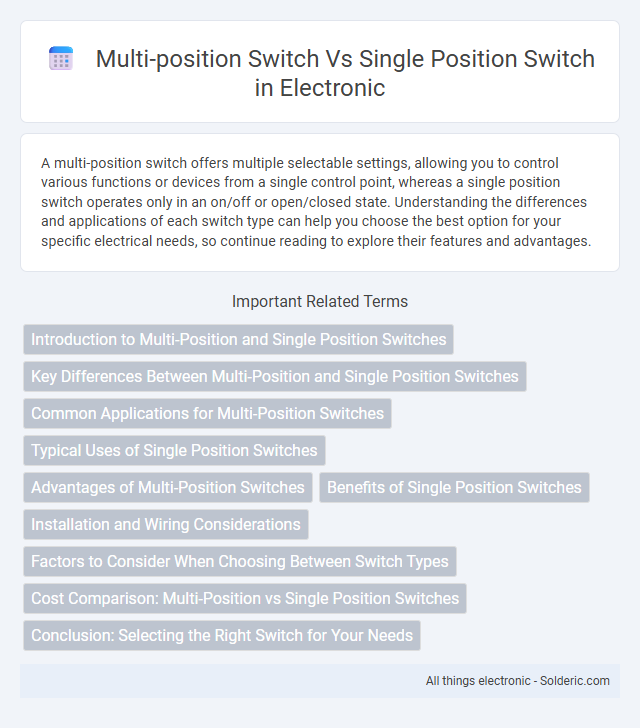A multi-position switch offers multiple selectable settings, allowing you to control various functions or devices from a single control point, whereas a single position switch operates only in an on/off or open/closed state. Understanding the differences and applications of each switch type can help you choose the best option for your specific electrical needs, so continue reading to explore their features and advantages.
Comparison Table
| Feature | Multi-Position Switch | Single Position Switch |
|---|---|---|
| Definition | Switch with multiple selectable positions | Switch with only one ON/OFF position |
| Functionality | Allows selection between several circuits or modes | Controls a single circuit; simple ON or OFF operation |
| Use Cases | Mode selectors, volume controls, multi-speed fans | Light switches, power toggles |
| Complexity | Higher, due to multiple contact points | Lower, simple design |
| Cost | Generally more expensive | Usually cheaper |
| Installation | Requires careful wiring for each position | Simple wiring |
| Examples | Rotary switches, rotary dial selectors | Toggle switches, push-button switches |
Introduction to Multi-Position and Single Position Switches
Multi-position switches allow users to select from multiple circuit connections or settings, offering greater control and versatility in electronic devices. Single position switches, by contrast, operate with a simple on/off mechanism or a single function, making them suitable for basic applications. Understanding the difference in functionality and application between these switches is essential for efficient electrical circuit design.
Key Differences Between Multi-Position and Single Position Switches
Multi-position switches offer multiple distinct circuit connections or settings, allowing you to control various functions with a single device, while single position switches control only one circuit or function. The key differences lie in versatility and complexity: multi-position switches can manage multiple operational modes or voltage levels, whereas single position switches provide simple on/off or single-state control. Selecting the right switch depends on your requirement for either multi-functional control or straightforward switching.
Common Applications for Multi-Position Switches
Multi-position switches are commonly used in applications requiring precise control over multiple circuit states, such as audio equipment for selecting input sources, industrial machinery for mode selection, and HVAC systems for fan speed control. These switches enable users to toggle between various settings seamlessly, providing flexibility and enhanced functionality compared to single-position switches that only allow simple on/off operations. Multi-position switches are essential in complex electronic devices, automotive dashboards, and home appliances where multiple operational modes are necessary.
Typical Uses of Single Position Switches
Single position switches are typically used in applications requiring straightforward on/off control, such as lighting fixtures, basic appliances, and simple machinery. These switches provide reliable operation in circuits where only one state selection is necessary, offering ease of use and cost-efficiency. Your home or office devices often rely on single position switches for consistent performance and simplicity in everyday use.
Advantages of Multi-Position Switches
Multi-position switches offer enhanced control versatility by allowing multiple circuit paths or settings within a single device, reducing the need for multiple individual switches. They provide space-saving benefits and simplify complex circuit management, making them ideal for applications requiring frequent selection changes. Your projects gain improved functionality and efficiency through the precise selection capabilities of multi-position switches.
Benefits of Single Position Switches
Single position switches offer straightforward operation and reliability due to their simple on/off functionality, reducing the risk of user error. Their compact design makes them ideal for applications where space is limited and consistent performance is essential. You gain ease of installation and maintenance, making single position switches a cost-effective solution for many electrical systems.
Installation and Wiring Considerations
Multi-position switches require careful installation due to multiple connection terminals, demanding precise wiring to ensure each position functions correctly and prevents circuit errors. Single-position switches have simpler wiring with typically two terminals, allowing for straightforward installation in basic on/off applications. Proper labeling and use of wiring diagrams are essential for both switch types to avoid miswiring and ensure reliable operation.
Factors to Consider When Choosing Between Switch Types
When choosing between a multi-position switch and a single-position switch, consider the complexity of your circuit and the number of control points needed. Multi-position switches offer greater versatility for selecting multiple outputs or settings, while single-position switches provide simplicity and reliability in straightforward on/off applications. Evaluate your device's operational requirements, including user interface preferences and space constraints, to determine the most suitable switch type for your project.
Cost Comparison: Multi-Position vs Single Position Switches
Multi-position switches generally cost more than single position switches due to their complex design and increased number of contacts, which provide greater functionality and flexibility in controlling multiple circuits. Single position switches, being simpler, offer a more budget-friendly option suitable for straightforward applications with limited switching needs. Your choice should weigh the added expense of multi-position switches against the benefit of versatile control in multi-circuit environments.
Conclusion: Selecting the Right Switch for Your Needs
Choosing the right switch depends on the complexity of your application and the level of control required. Multi-position switches offer greater flexibility with multiple circuit options, making them ideal for devices needing more than simple on/off functionality. Single position switches provide straightforward control for basic operations, ensuring reliability and ease of use in simpler systems.
multi-position switch vs single position switch Infographic

 solderic.com
solderic.com